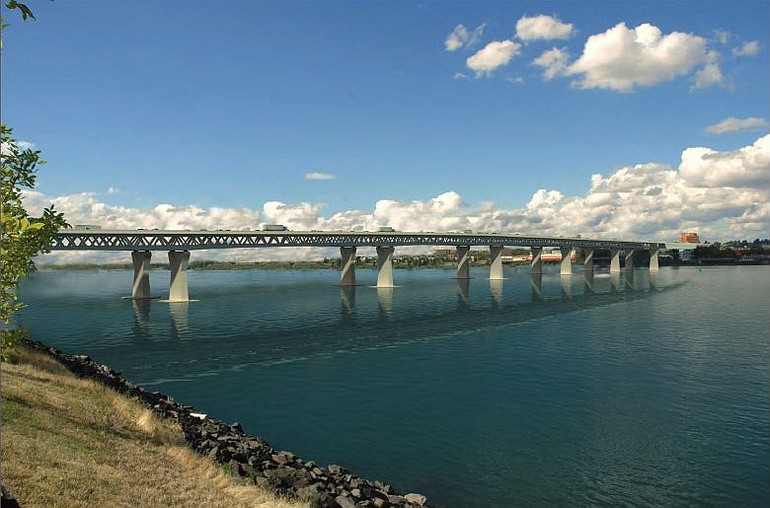The bistate Columbia River Crossing project has consumed $118 million without turning a single shovel full of dirt.
What did we get for all that money?
The Columbian requested all information related to project expenditures from the project office in Vancouver. This week, the newspaper received two discs full of hundreds of pages of invoices, receipts, time sheets, color-coded reports and other items describing expenditures since 2005.
As we pore over the data, we’re also making it available to the general public at www.columbian.com/i5bridge. We invite you to page through more than 350 files. If you find something that raises questions or causes concern, drop a line to erik.robinson@columbian.com.
The crossing is the biggest single public works project in the region’s history.
Now estimated to cost $3.6 billion, the overall project will replace the existing twin three-lane drawbridges with a 10-lane river crossing, extend Portland’s light-rail transit system into Vancouver and improve five miles of Interstate 5 across two states.
The bistate Columbia River Crossing project has consumed $118 million without turning a single shovel full of dirt.
What did we get for all that money?
The Columbian requested all information related to project expenditures from the project office in Vancouver. This week, the newspaper received two discs full of hundreds of pages of invoices, receipts, time sheets, color-coded reports and other items describing expenditures since 2005.
As we pore over the data, we're also making it available to the general public at www.columbian.com/i5bridge. We invite you to page through more than 350 files. If you find something that raises questions or causes concern, drop a line to erik.robinson@columbian.com.
The crossing is the biggest single public works project in the region's history.
Now estimated to cost $3.6 billion, the overall project will replace the existing twin three-lane drawbridges with a 10-lane river crossing, extend Portland's light-rail transit system into Vancouver and improve five miles of Interstate 5 across two states.
State transportation officials will conduct two listening sessions today regarding their proposed recommendation for a composite truss bridge design. The first will be from noon to 2 p.m. at the Portland Expo Center, Hall D, 2060 N. Marine Drive in Portland. The second will be from 6 to 8 p.m. at the Washington Department of Transportation, 11018 N.E. 51st Circle in Vancouver. Comments also can be submitted online at columbiarivercrossing.org.
The proposed design for a new Interstate 5 bridge is coming in for a rough review among architects and design professionals.
They say the composite deck truss is, in a word, ugly.
Worse, they say, the truss design may not turn out to be as inexpensive or as expedient as the more visually appealing cable-stayed alternative. That’s because an ugly bridge is more likely to generate continued citizen opposition and legal challenges, according to a summary of concerns by members of the bistate Columbia River Crossing’s urban design advisory group.
The cable-stayed alternative has three large piers in the water, as opposed to 10 with the truss design.
Govs. Chris Gregoire and John Kitzhaber agreed with a bridge expert review panel’s recommendation last month to kill the previous open-web box girder design because of its high cost and questionable durability. They are weighing three alternatives put forward by the expert panel: cable-stayed, tied-arch and the composite deck truss designed preferred by the two state transportation departments.
The deck truss option uses standard construction techniques and straightens the alignment across the river.
But it looks similar to the old design, which was derided by critics for its bland appearance.
“They totally ignored the aesthetic aspect,” said Arden Newbrook, a member of the Vancouver chapter of the American Institute of Architects. “It’s all been swept under the carpet in the name of expediency.”
On Tuesday, nine members of the crossing project’s urban design advisory group unanimously recommended the cable-stayed design.
Panelist Walter Valenta said even though the estimated cost of the truss design is marginally cheaper than the cable-stayed version, both designs are less expensive than the previous CRC design. He noted that the recent expert review panel concluded that the cable-stayed bridge performed better on environmental and seismic measures. And the $60 million difference between the truss and the cable-stayed bridge types is a fraction of the $3.6 billion cost of the overall project, which includes an extension of Portland’s light-rail transit system along with dozens of elevated ramps and overpasses on five miles of I-5 spanning the two states.
“It’s still a lot of money for people,” Valenta said. However, “we feel the designs are closer in price when you factor in the upgrades necessary for the flat bridge.”
He said costs for the truss design could rise significantly if project planners curve the alignment, forcing them to add piers in the water. Further, he said, it will cost money to dress it up with cosmetic improvements pledged by state transportation officials.
Aesthetics is not a trivial matter on a bridge connecting two states across one of the great rivers of the world, he said.
“This is not a low bridge. It has 95 feet of clearance underneath, and it’s 10 or 12 stories up in the air,” Valenta said. “We feel the cable-stay matches the setting appropriately.”
The bridge expert review panel concluded that the truss bridge improves on the old CRC design, but it’s no thing of beauty.
“It is difficult to present any truss bridge as an architectural solution that would be appropriate for this special crossing of the Columbia River,” according to the panel’s report.
Erik Robinson: 360-735-4551 or erik.robinson@columbian.com.



